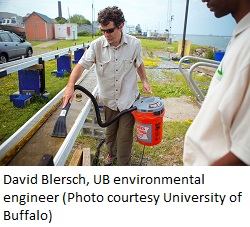 One of the scourges of lakes during summertime is an algae bloom. While some algae serves as an important part of the food chain, other varieties can become too plentiful and kill off large amounts of wild fish. Researchers from the University of Buffalo are looking at ways to remove that slimy, green mess and turn it into useful materials, such as biofuels.
One of the scourges of lakes during summertime is an algae bloom. While some algae serves as an important part of the food chain, other varieties can become too plentiful and kill off large amounts of wild fish. Researchers from the University of Buffalo are looking at ways to remove that slimy, green mess and turn it into useful materials, such as biofuels.
Funded by a $30,000 Rochester Institute of Technology grant, [David] Blersch, an environmental engineer at the University at Buffalo, and his students built a system that pumps water ashore down two, 40-foot-long flumes.
The water is recycled into the lake but it leaves behind microscopic cells that form miniature algae blooms. Blersch vacuums the algae and bottles samples to study. He is creating a database that will help scientists, government, industry and others gauge the algae’s potential uses.
“One element of the project is pollution recovery. By using the algae beds to remove excess nutrients from the lake, we can improve water quality,” says Blersch, PhD, research assistant professor in UB’s School of Engineering and Applied Sciences. “The other aspect is studying its properties; is it viable to turn algae into biofuels, fertilizer or other commercial products?”
The technology is being looked at to help clean up and possibly collect algae to make into biofuels in other important watershed, such as the Chesapeake Bay and the Everglades. In addition, companies, such as Exxon Mobil, which has invested $100 million since 2009 in algae biofuels, are helping move the process along.

